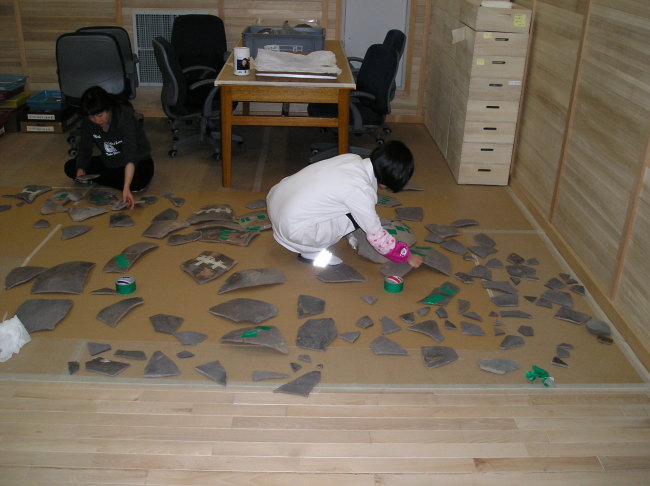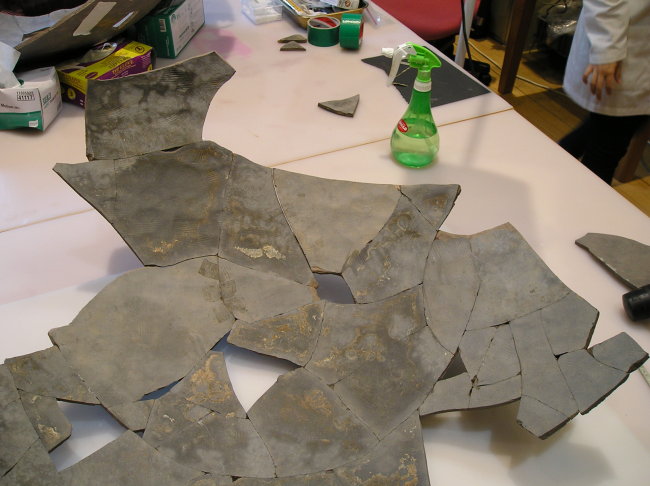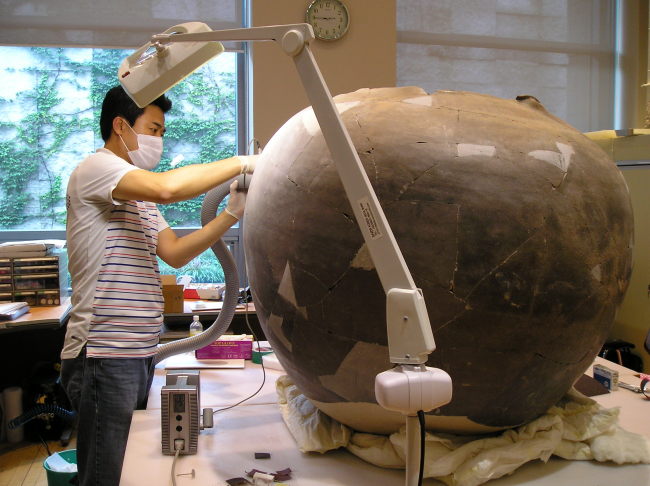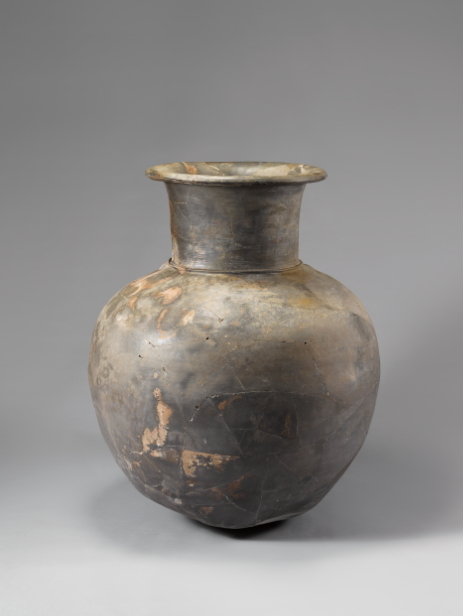Since 1964, some 120 pottery pieces have been kept in national artifact storage with other relics excavated from Geumgangsa Temple in Buyeo, South Chungcheong Province.
For 46 years, they were filed under the label “unidentified artifact,” without any records pointing their original form, until Hwang Hyun-seong, conservator at the National Museum of Korea, started to put the pieces together in 2011.
It took about a year to assemble the hundreds of pieces and discover that they formed a 1.5-meter-tall gray, brownish jar that dates back to the Goryeo Dynasty (918-1392).
 |
Restoration process of a Goryeo Dynasty jar: Sorting boken pieces (The National Museum of Korea) |
 |
Restoration process of a Goryeo Dynasty jar: Putting broken pieces together (The National Museum of Korea) |
“I had no idea what they were when I was first handed a plastic box full of pottery pieces. They had been kept in a plastic box for a long time,” said Hwang at the National Museum of Korea in Seoul on Monday. “It was hard to guess the original form of the jar in the beginning. But as I began to put the pieces together, I saw the picture of a big jar.”
The Goryeo Dynasty jar is one of 28,000 artifacts, or pieces thereof, the National Museum of Korea has restored in the last 40 years. In celebration of the 40th anniversary of the museum’s conservation work, the NMK is holding an exhibition to showcase 57 artifacts restored by the museum conservators.
Divided into five sections, the exhibition guides viewers through the world of conservation science, offering insights into the methodologies of conservation science, major restoration projects and preventive conservation that extends the life of artifacts.
 |
Restoration process of a Goryeo Dynasty jar: Conservator Hwang Hyun-sung assembles the upper part of the jar (The National Museum of Korea) |
 |
Restoration process of a Goryeo Dynasty jar: Filling in the missing parts (The National Museum of Korea) |
Conservators use a variety of methods and technologies to understand composition and physical properties of artifacts, and how they have changed over time. Basic research involves using diverse electromagnetic waves such as X-rays and CT scans, which are also used to examine the human body.
Through the use of X-rays and CT scans, conservators identify the approximate year artifacts were made and also discover hidden stories.
For instance, to date a Joseon era portrait of a man named Jeong Gon-su, the museum used X-rays to examine the painting. The X-rays showed another layer with a portrait of an unknown Chinese man in a formal Qing Dynasty (1644-1911) costume. The painting had long been believed to be from the late 16th century, but scientific research confirmed the portrait was painted in the late 17th century, after the establishment of the Qing Dynasty.
 |
Restored Goryeo Dynasty jar (The National Museum of Korea) |
Through CT scans, conservators can approximate a 3-D image for the artifact and also discover the condition of mummies. For example, conservators used CT scans to examine a 17th century mummy that had been excavated with 85 relics, including clothes and documents that identified the mummy as a man named Lee Jing, who died on Nov. 6, 1642. Such records also offered conservators an understanding of the clothing and funeral customs of the early 17th century.
Recently, 3-D printing technologies have been applied to conservation work, opening new possibilities in cultural heritage conservation.
An earlier restoration work on a Song Dynasty porcelain pitcher with half of its body broken had failed to recreate the delicate dragon pattern on the body. In an attempt to reconstruct the pattern, conservators used 3-D technologies to recreate the pattern and printed it in a 3-D model, which was then used to restore the pitcher’s original form.
“When it is impossible to restore the broken piece of a pottery surface, we make a 3-D model of it and attach it on the missing part to help viewers understand the artifact better,” said Hwang.
 |
Song Dynasty white porcelain pitcher before and after restoration using 3-D modeling technology (The National Museum of Korea) |
Currently, the museum’s conservatory lab is working on restoring three Korean artifacts consigned by three museums in Germany, including 14th and 16th century Buddhist paintings from the Museum of East Asian Art, Cologne and a 19th century folding screen from the Museum of Ethnology, Hamburg. The open lab is available for viewing at 10 a.m. and 2 p.m. during the exhibition period.
“Conservation Science: Saving Cultural Properties” runs until May 8 at the Special Exhibition Gallery on the first floor of the NMK. For more information, visit
www.museum.go.kr.
By Lee Woo-young (
wylee@heraldcorp.com)









![[Weekender] Korea's traditional sauce culture gains global recognition](http://res.heraldm.com/phpwas/restmb_idxmake.php?idx=644&simg=/content/image/2024/11/21/20241121050153_0.jpg)



